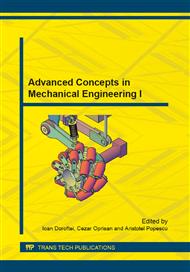p.167
p.173
p.177
p.183
p.189
p.195
p.201
p.207
p.213
Experimental Analysis Regarding the Degree of Plastic Deformation of Fractured Surfaces under da/dN, KIc and JIc Determination
Abstract:
When loaded over their yield strength, materials suffer significant plastic deformations. In such zones, the degree of plastic deformation depends on the characteristics of the material and also on the nature of the loading. As known, the degree of plastic deformation may be correlated with the value of hardness, determined in the plastically-deformed zone. The present paper discusses the three types of testings applied, which led to the fracture of some specimens and, consequently, to plastic deformations in the immediate vicinity of the fractured surfaces. The testings, performed on Compact Tension Specimens, aimed at determining the following characteristics developed by the Mechanics of fracture: the crack growth rate, da/dN, fracture toughness for materials with brittle behavior, KIc, and fracture toughness for the materials with a preponderantly ductile character, JIc. Along the surfaces fractured during these testings, plastic deformations occur, differentiated exactly by the load differences. Under such conditions, testings were made upon the 1C45 (1.053) steel, with the characteristics established by the manufacturer, as well as upon the same steel, yet subjected to an annealing thermal treatment, and the variations of Vickers hardness were recorded both along the fractured surfaces and from one specimen to another.
Info:
Periodical:
Pages:
189-194
Citation:
Online since:
October 2014
Authors:
Keywords:
Price:
Сopyright:
© 2014 Trans Tech Publications Ltd. All Rights Reserved
Share:
Citation:


